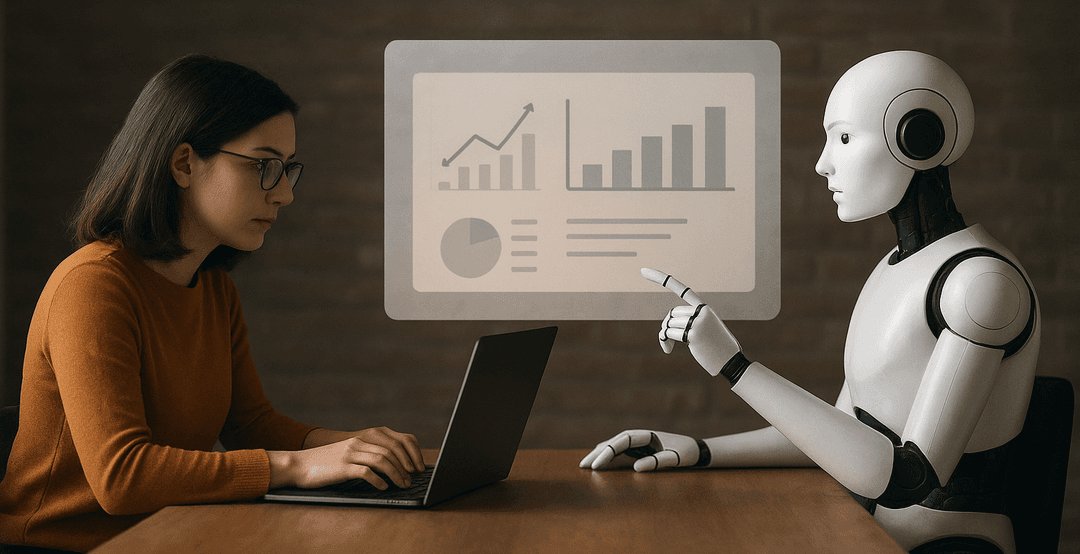August 7, 2025
/
How Human-Machine Collaboration is Changing the Future of Work

When machines take on many of the routine chores that people used to only perform, human-machine collaboration is changing the way we think about occupations, tasks, and responsibilities.
Powered automation and data analysis are just two examples of how human-machine cooperation is being incorporated into nearly every industry. This essay will examine the potential and problems that come with the revolutionary shift in the nature of work toward human-machine collaboration.
How Does Human-Machine Collaboration Operate?
Human-machine collaboration is based on the core concept that computers can perform regular tasks like data input and analysis, freeing up humans to do what they do best think creatively, and solve problems.
In order to produce something new, human creativity and artificial intelligence are combined. This can be used to solve complicated issues, develop products, or write stories. Because of this, we can combine the unique abilities of people and robots to complete jobs that would take us far longer to complete alone.
The Advantages of Using Machine-Human Cooperation
87% of businesses worldwide, according to a poll, think AI technology can offer them a competitive advantage. Considering this astounding number, it is clear that integrating human-machine collaboration can provide a number of advantages and generate new opportunities for companies to boost productivity and establish more effective work environments.
Increased Productivity
Human-machine collaboration boosts productivity and lowers errors from a business standpoint. More work can be completed in less time thanks to machines' far faster rate of operation than that of people. Thus, companies can use AI to automate monotonous jobs so that staff members can concentrate on higher-value work. Can, according to a poll, raise worker productivity by an estimated 40% by 2035, resulting in increased effectiveness and quicker task completion.
Data Accuracy and Analysis
Utmost data accuracy, analysis, and insights can now be obtained by combining human and machine intelligence.
To fully utilize an organization's data and analytics capabilities, businesses must be able to make better-informed decisions regarding their operations, goods, and services. This may be achieved by utilizing driven insights to supplement human judgment.
Improved Customer Service
It is predicted that enabled solutions will handle 95% of all customer contacts by 2025, signaling a significant change in the way that customers and enterprises communicate. Customer satisfaction rises when businesses use AI algorithms to deliver quicker and more accurate customer service.
Conversion rates rise as a result, and the company makes more money. can also aid companies in automating repetitive jobs like answering questions or requests from clients, freeing up staff members' time to concentrate on more difficult jobs like making tailored recommendations or advice.
Identifying the Challenges that Come with Human-Machine Collaboration
Human-machine collaboration provides its own set of obstacles in addition to its many benefits.
Bias
The fundamental problem with AI technology is that it is fallible and subject to prejudice. As a result, humans must continuously check machine output to make sure it is impartial and correct. Furthermore, is limited in its ability to comprehend context, which makes it challenging for robots to evaluate data in more complicated scenarios.
Miscommunication
Another difficulty with human-machine collaboration is that it can be quite taxing because successful outcomes need both sides to perform at the highest level possible. This means that for humans and robots to collaborate effectively, there must be a great deal of communication as well as a solid grasp of one another's advantages and disadvantages.
Adaptability and Flexibility
People can quickly learn new abilities or techniques, make quick decisions, and apply their skills to a variety of settings. Conversely, for robots to become as adaptive as humans, they need constant programming.
The Prospects for Human-Machine Coordination
Humans and machines working together are becoming more commonplace. To generate content, automate processes, and complete monotonous tasks, we rely on our machines. Even while this technology has a lot of potential for efficiency, a few problems still need to be fixed before human-machine collaboration is completely successful.
For example, given that machines are increasingly making decisions for us, how can we ensure that they act morally? How can we ensure that human decision-making is not overly dependent on robots when it comes to critical decisions? We need answers to a few important questions before we can completely integrate human-machine collaboration into our daily lives.
Nevertheless, in the coming years, human-machine collaboration is expected to change and completely transform the way we operate as robots grow in capability and strength. Between 2022 and 2030, the use of AI in businesses is expected to increase dramatically, with a projected CAGR of 38.1%.
Actually, firms will have more options to enhance customer service, create better products and services, and run more smoothly thanks to this new kind of human-machine partnership
In the end, intelligent solutions might arise from fusing the advantages of both humans and robots, such as cognitive ability, problem-solving skills, creativity, and intuition. All linked industries can benefit from a more productive, efficient, and better future created by humans and machines working together.










